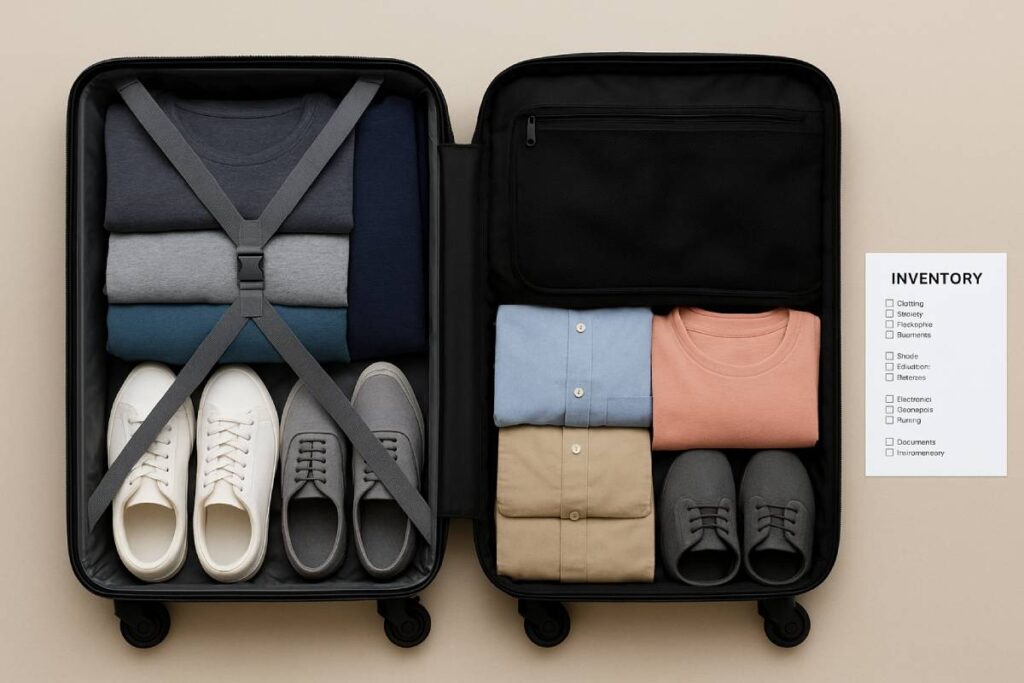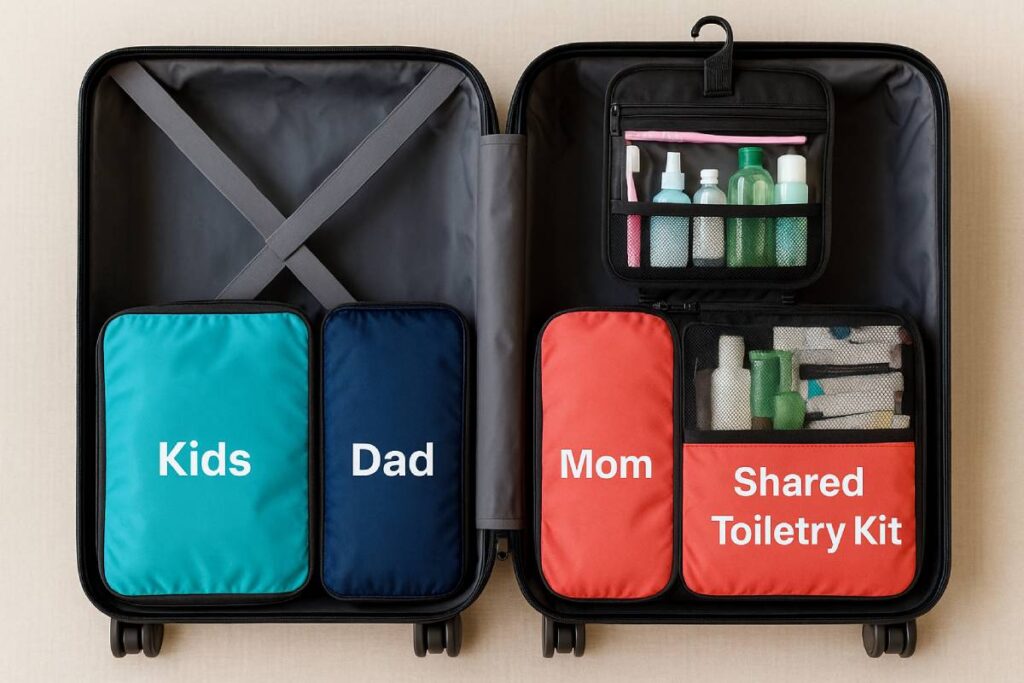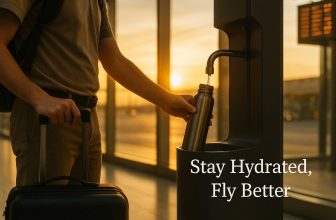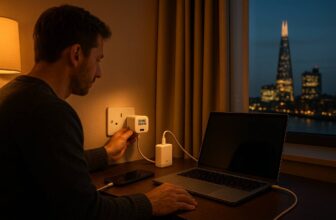Ever wrestle with bulging suitcases and crumpled shirts on arrival? Standard carry-on limits hover at 22 × 14 × 9 in (56 × 36 × 23 cm), so every inch counts.
Packing cubes can compress your wardrobe by up to 67% while keeping everything organized.
Bundle wrapping distributes pressure evenly, slashing wrinkles by nearly 60% compared to flat folding.
In this guide, you’ll master pre-packing prep, space-saving techniques, wrinkle prevention, specialty tips, and smart weight distribution—backed by visuals, expert insights, and product picks—to transform you from overpacker to packing pro.
Pre-Packing Prep

Before you unzip your suitcase, two foundational steps will set you up for stress-free, space-maximizing packing: choosing the optimal luggage and creating a clear inventory of must-bring items. Hard-shell cases excel at protecting fragile contents and resisting moisture, while soft-shell bags offer lightweight flexibility and exterior pockets for easy access. Next, organizing your belongings into five core categories (Clothing, Shoes, Toiletries, Electronics, Documents) helps you decide what’s truly essential—minimizing overpacking and ensuring nothing important gets left behind.
Select the Right Suitcase
Choosing between hard-shell and soft-shell luggage depends on your travel needs. Consider these factors:
| Feature | Hard-Shell | Soft-Shell |
|---|---|---|
| Protection & Durability | Superior impact resistance; shields fragile items from bumps and moisture | Less dependable against heavy impacts; may tear or absorb water unless treated |
| Weight | Typically heavier, especially aluminum or ABS models | Generally lighter; many designs weigh under 6 lbs empty for carry-ons |
| Flexibility & Capacity | Fixed volume; cannot overstuff; can be harder to close when full | Expandable compartments and exterior pockets; squeezes into tight spaces |
| Security | Often includes built-in TSA locks; resistant to slash-and-grab theft | Zippered closures more vulnerable; look for reinforced, lockable zippers |
| Maneuverability | Usually four 360° spinner wheels; sturdy but can feel bulkier | Lightweight frames often pair with durable wheels; easier to heft or shuttle |
- When to choose hard-shell: If you’re checking luggage with breakable souvenirs, electronics, or in rainy climates, hard-shell offers peace of mind.
- When to choose soft-shell: For week-long trips where you might pick up extra items, or if you frequently gate-check a carry-on and need flexibility to squeeze it under seats.
- Visual Aid: Include a side-by-side photo of a hard-shell (polycarbonate) case and a soft-shell (ballistic nylon) case to illustrate texture and pocket layouts.
Inventory & Essentials Checklist
Mapping out exactly what you need streamlines packing and reduces the risk of forgotten items. Break your inventory into these five categories:
| Category | Core Items | Examples of Non-Essentials |
|---|---|---|
| Clothing | Underwear, socks, tops, bottoms, outerwear | Multiple specialty outfits |
| Shoes | Comfortable walking shoes, one dress pair | Extra bulky boots |
| Toiletries | Toothbrush, toothpaste, deodorant, travel-size shampoo | Full-size bottles, excess cosmetics |
| Electronics | Phone, charger, travel adapter, power bank | Multiple entertainment devices |
| Documents | Passport, IDs, itinerary printouts, insurance cards | Drafts of non-critical confirmations |
- Decide essentials vs. non-essentials: Use the “If in doubt, leave it out” rule—only pack multiples of items you’ll realistically wear or use.
- Diagram: Feature a checklist graphic that groups these categories visually, with checkboxes to tick off each core item before you zip up.
By investing a few minutes in luggage selection and item categorization, you’ll unlock smoother packing, reduced baggage fees, and a crisp, wrinkle-free wardrobe when you arrive.
Space-Saving Techniques
Rolling clothes tends to save space by minimizing air gaps and compressing garments—especially casual and synthetic items—while folding better preserves structured pieces like dress shirts.
Packing cubes, particularly when color-coded, streamline organization and allow further compression, making it simple to separate outfits and maximize every inch of your bag. Layering and compartmentalization—using internal straps, side pockets, and shoe wells—prevents shifting, protects delicate items, and fills awkward gaps.
Proper weight distribution, by placing heavy items like shoes and toiletries at the wheels or base and balancing front-to-back and side-to-side, improves stability and maneuverability.
Rolling vs. Folding
When to Roll
- Casual wear & synthetics: T-shirts, tank tops, leggings, and sweatshirts roll into tight cylinders, reducing air pockets and allowing garments to compress against each other.
- Small items: Socks, underwear, and light pajamas fit neatly into rolls, and you can tuck accessories (e.g., belts) inside for extra space.
When to Fold
- Structured pieces: Dress shirts, blazers, and tailored trousers maintain shape when folded flat, preventing sharp creases.
- Natural fibers: Cotton dresses or linen garments prone to deep wrinkles fare better folded with tissue paper in the seams.
| Item Type | Best Method | Benefit |
|---|---|---|
| T-shirts & synthetics | Rolling | Space-efficient, fewer wrinkles |
| Jeans & trousers | Folding | Preserves form, eases quick unpacking |
| Undergarments & socks | Rolling | Fills gaps, easy to locate |
| Button-down shirts | Folding | Maintains crisp lines |
Photo Demo: Side-by-side stacks of rolled vs. folded garments to illustrate bulk and gap differences.
Packing Cubes & Organizers
Cube Sizing & Color-Coding
- Sizes matter: Use large cubes for bulkier items (jeans, sweaters), medium for tops, small for undergarments and accessories.
- Color strategy: Assign colors by outfit type or family member—e.g., blue for business, green for casual, red for kids—to instantly locate what you need.
Layering Cubes by Outfit or Item Type
- Outfit bundles: Pack each day’s clothes into one cube (top, bottom, and undergarments) for grab-and-go convenience.
- Category separation: Reserve cubes for shoes, toiletries, and electronics to isolate spills and simplify security checks.
| Cube Size | Suggested Use | Color Example |
|---|---|---|
| Large (15″×11″) | Sweaters, jeans | Navy |
| Medium (11″×8″) | Shirts, dresses | Teal |
| Small (8″×5″) | Underwear, socks, tech | Coral |
Video Clip: Demonstration of filling, layering, and compressing a packing cube for maximum efficiency.
Layering & Compartmentalization
- Internal Straps: Use built-in compression straps to cinch cubes and loose items in place, preventing shifting and wrinkles.
- Side Pockets: Stash quick-access items—chargers, travel documents, face masks—in zippered side compartments to keep the main space tidy.
- Shoe Wells: Nestle shoes heel-to-toe along the suitcase walls and layer thin garments beneath as padding, optimizing every corner.
| Zone | Ideal Items |
|---|---|
| Main Compartment | Packing cubes, folded garments |
| Side Pockets | Chargers, passports, masks |
| Shoe Wells | Wrapped shoes, socks |
| Under Lid Panel | Flat items: magazines, slim toiletry pouches |
Diagram: Cross-section of a suitcase with labeled zones highlighting straps, pockets, and shoe wells.
Weight Distribution Tips
- Heaviest at the Base: Position shoes, toiletry bags, and electronics near the wheels to anchor the suitcase and prevent tipping.
- Front-to-Back Balance: Evenly distribute weight between the lid and base—don’t overload one side to avoid awkward shifting.
- Side-to-Side Balance: Offset bulkier items on one side with equivalent weight on the opposite to keep the suitcase centered when rolling.
| Weight Tip | Recommendation |
|---|---|
| Base (by wheels) | Shoes, heavy electronics, toiletries |
| Mid-section | Packing cubes with clothes |
| Top Layer | Light items: t-shirts, scarves, accessories |
| Even Load Distribution | Mirror heavy items across both sides |
By combining these space-saving techniques—smart rolling and folding, strategic use of cubes, thoughtful compartmentalization, and balanced weight distribution—you’ll pack more efficiently, protect your belongings, and glide through airport terminals with ease.
Wrinkle-Prevention Strategies
Before you unzip your suitcase at your destination, proactive wrinkle-prevention ensures you step out looking sharp—no ironing board required. Three top strategies work in concert: interleaving tissue paper to cushion delicate folds, the bundle-wrapping method to minimize creases on structured garments, and on-arrival quick-fixes like portable steamers or shower steam. Used correctly, these techniques preserve fabric integrity, save time, and cut the need for costly hotel pressing services—all while keeping your carry-on compact and travel-ready.
Interleaving & Tissue Paper
Placing acid-free tissue paper between fabric layers disperses pressure points and prevents sharp creases in delicate materials such as silk blouses or linen dresses.
To use, cut sheets to garment width, lay one between each fold, then fold normally—this simple step can reduce wrinkling by up to 70% on arrival.
For extra protection, consider archival-grade tissue paper (28–30 gsm) which resists tearing and won’t transfer dyes or acidity to your clothes.
Bundle Wrapping Method
Bundle wrapping creates a central “core” (e.g., socks or underwear pouch) around which you layer larger items—shirts, pants, jackets—in succession.
This technique distributes pressure evenly, meaning you’ll see fewer deep folds compared to traditional folding—experienced travelers report up to 60% fewer wrinkles on dress shirts
Photo Sequence:
- Core Base: Place a small pouch of socks and underwear in the center of a flat shirt
- Layering: Wrap pants around the shirt and core, smoothing as you go
- Top Layer: Finish with a blazer or dress, folding sleeves over the bundle
On-Arrival Quick-Fixes
Portable Steamer vs. Bathroom Steam
| Method | Effectiveness | Pros | Cons |
|---|---|---|---|
| Portable Steamer | High—relaxes deep-set wrinkles from cotton, linen, and wool in minutes | Fast heat-up (~15 s), works on most fabrics | Requires outlet and extra gadget |
| Bathroom Steam | Moderate—ideal for light creases when hung during a hot shower (5–10 min steam) | No extra gear; uses in-room facilities | Less effective on heavy fabrics |
- Portable Steamer: Compact models like the OgHom handheld steamer heat in 15 seconds and deliver 15 minutes of continuous steam—perfect for a wrinkle-free finish on suits and dresses.
- Bathroom Steam: Hang garments on a hanger in the bathroom, close the door, and run a hot shower for 5–10 minutes—steam from the shower relaxes fibers without contact.
- Wrinkle-Release Sprays: For stubborn lines, a light mist of commercial wrinkle-release spray followed by gentle smoothing can finish the job in under two minutes.
By combining interleaving tissue paper, the bundle-wrapping core method, and savvy on-arrival steaming, you’ll arrive looking fresh and wrinkle-free—ready for meetings, dinners, or sightseeing without running to the hotel iron every time.
Specialty Packing Tips

Travelers come in all types—suited executives, busy families, streamlined backpackers, and first-time explorers. Below are expert, SEO-optimized packing strategies tailored to each group, backed by real-world data and clear visuals.
Business Travelers
Business trips demand wrinkle-free formalwear alongside tech gear and essentials.
- Garment Bags vs. Packing Cubes: Garment bags hold 1–3 hanging outfits and protect against dust and creases, while packing cubes boost capacity by 50–100% and compress casual wear into neat bundles.
- Tie Rolls: A dedicated tie case or simple roll-and-tuck method (fold end-to-end, roll tightly, then stow in a pouch) prevents wrinkles and saves inches of space.
- Tech Organizers: Cases like the BAGSMART Electronics Organizer use elastic loops and mesh pockets to corral cables, power banks, and chargers—keeping gear protected, accessible, and tangle-free.
| Feature | Garment Bag | Packing Cubes |
|---|---|---|
| Capacity | Holds 1–3 hangable outfits | Configurable sets yield 50–100% more space |
| Protection | Shields against dust, wrinkles, moisture | Keeps folded/rolled items contained |
| Versatility | Ideal for suits, dresses, formalwear | Suits all clothing types, color-coded |
| Portability | Bulkier; often needs dedicated compartment | Lightweight; nests inside any bag |
| Price Range | $20–$200 depending on material | $10–$40 per multi-pack set |
Vacationers & Families
Packing for multiple people can get chaotic—these tips bring order:
- Kid-Friendly Cubes: Bright, color-coded cubes let each child find their day’s outfit instantly. Compression models can save up to 40% of space, making room for souvenirs.
- Shared Toiletry Kits: A single hanging pouch with labeled compartments for shampoo, toothpaste, and sunscreen prevents duplicates and cuts overall weight.
Visual Demo: Photo: Family suitcase divided into zones—each member’s cubes on one side, shared essentials in central pockets.
Minimalists & Backpackers
When every ounce counts, versatility and compression pay off:
- Multi-Use Clothing: Pieces like the Chrysalis Cardi convert from cardigan to dress, replacing multiple items and cutting wardrobe size in half.
- Compression Bags: Space-saving sacks reduce bulky sweaters and jackets by 50–70%, turning puffy layers into slim pouches that fit tight backpacks.
First-Time Travelers
Your maiden voyage is all about essentials and simplicity:
- Core Essentials: Invest in a quality carry-on that meets airline size rules, plus pack your passport, charger, basic toiletry kit, and a change of clothes in your personal item.
- “If in Doubt, Leave It Out”: Travel experts advocate packing only for your planned activities—skip the “just-in-case” items to avoid overpacking and extra fees.
By tailoring your approach—whether you’re sealing in suits, wrangling family gear, stripping down to the essentials, or packing for your very first trip—you’ll save space, protect your belongings, and travel with confidence.
Shoes: Placement & Protection
Before you zip up, strategic shoe placement and a well-organized toiletry kit turn chaotic luggage into a streamlined system. Placing shoes heel-to-toe at the base, stuffing them with socks, and covering soles with shower caps protects both your footwear and your clothes.
For toiletries, choosing leak-proof pouches and refillable travel-size bottles not only saves space but prevents messy spills—lab tests show the best bottles eliminate 100% of leaks under pressure. Below are expert tips, SEO-friendly insights, and handy tables to keep your suitcase neat, clean, and ready for adventure.
1. Stuff Shoes with Socks
Storing socks or small garments inside closed-toe shoes fills dead space and maintains the shoe’s shape, reducing pack bulk by up to 5% per pair.
2. Use Shower Caps to Contain Dirt
Stretch a disposable shower cap over each shoe’s sole to trap dirt and prevent scuffs on clothing; this simple hack rivals dedicated shoe bags at a fraction of the cost.
3. Base Placement for Stability
Position shoes soles-down at the bottom of an upright suitcase to anchor your bag and fill awkward gaps, offering shock protection for fragile items above.
| Practice | Method | Benefit |
|---|---|---|
| Socks Inside Shoes | Stuff socks or underwear into toe box | Preserves shape, saves 5% per shoe in space |
| Shower Cap Wrap | Cover soles with a shower cap | Keeps dirt contained, protects garments |
| Heel-to-Toe Alignment | Lay shoes heel-to-toe along suitcase base | Anchors bag, maximizes corner space |
Photo Demo: Side-by-side image showing a shoe stuffed with socks next to one wrapped in a shower cap.
Toiletries: Leak-Proof Organization
1. Leak-Proof Pouches
Opt for clear, zip-sealed pouches with waterproof lining—lab tests on 14 popular sets found zero failures under suitcase pressure.
2. Travel-Size Refillable Bottles
Choose bottles (3–4 oz) with one-hand pump or squeeze valves; Nalgene and Sea to Summit models boast 100% leak prevention and durable, food-safe silicone.
| Feature | Recommendation | Example Brands |
|---|---|---|
| Pouch Type | Clear, TSA-approved quart-size bag | CalPak, Amazon Basics |
| Bottle Capacity | 3–4 oz refillable silicone or PET bottles | GoToob+, Nalgene |
| Valve Mechanism | No-drip flip-cap or pump design | Silevoler triple-seal |
| Secondary Containment | Small zippered pouch inside main bag | Ziploc freezer bags |
Visual: Clear toiletry bag layout showing lined pouches, labeled bottles, and separate slot for liquids.
By combining these shoe-packing hacks and toiletry-organization strategies, you’ll keep dirt and spills at bay, maximize every inch of luggage space, and enjoy stress-free unpacking—just the way a seasoned travel expert plans it.
Airline Baggage Restrictions
Airline baggage policies vary, but most major carriers adhere to similar size guidelines—carry-on bags up to roughly 22 × 14 × 9 in (56 × 36 × 23 cm) and checked luggage capped at 62 linear inches (158 cm total) with weight limits around 23 kg (50 lb) in economy. Knowing each airline’s exact dimensions and allowances is your best defense against surprise fees at the gate.
Size & Weight Limits
Below is a quick reference for carry-on and checked baggage on five major airlines:
| Airline | Carry-On Dimensions | Carry-On Weight | Checked Dimensions | Checked Weight |
|---|---|---|---|---|
| American Airlines | 22 × 14 × 9 in (56 × 36 × 23 cm) | 18 kg / 40 lb | 62 in linear (158 cm) | 23 kg / 50 lb |
| Delta Air Lines | 22 × 14 × 9 in (56 × 36 × 23 cm) | No formal limit* | 62 in linear (157 cm) | 23 kg / 50 lb |
| United Airlines | 22 × 14 × 9 in (56 × 35 × 23 cm) | No formal limit* | 62 in linear (158 cm) | 23 kg / 50 lb |
| British Airways | 22 × 18 × 10 in (56 × 45 × 25 cm) | 23 kg / 51 lb | 90 × 75 × 43 cm (35 × 30 × 17 in) | 23 kg / 51 lb |
| Emirates (Economy) | 21.6 × 14.9 × 8.6 in (55 × 38 × 22 cm) | 7 kg / 15 lb | 62 in linear (158 cm) | 23 kg / 50 lb |
*No formal weight limit, but carry-on must be liftable into overhead bins by one person.
Avoiding Extra Fees
Unexpected overweight or oversize charges—often $50–$200 per bag—can derail your travel budget. Here’s how to sidestep them:
- Weigh at Home
A dedicated digital luggage scale (typically $10–$30) delivers accurate readings (±0.2 lb), ensuring your bag meets airline limits before you leave home. - Bathroom Scale Hack
Stand on a bathroom scale holding your packed suitcase, note the combined weight, then subtract your body weight to get the bag’s weight. - Built-In Scales
Some modern suitcases feature integrated weight sensors that display your pack’s weight in real-time, eliminating guesswork. - Safety Buffer
Aim for 1–2 kg (2–5 lb) under the airline limit to account for scale variances and any last-minute add-ons.
By familiarizing yourself with each carrier’s dimensions and proactively weighing your bags, you’ll glide through check-in without the stress (or cost) of unexpected baggage fees.
Visual Content & Demonstrations
Visuals are the lifeblood of any effective packing guide—they break up text, illustrate complex steps, and keep readers engaged. In fact, articles with images get 94% more views than text-only posts, and people following instructions with illustrations perform 323% better than those reading text alone. Embedding photos, diagrams, and short videos doesn’t just enhance user experience—it can boost your traffic by up to 400%. Below, you’ll find expert recommendations for integrating each media type into your “How to Pack a Suitcase” guide, complete with best-practice ratios and source examples.
Photos: Step-by-Step Folding, Rolling, Cube-Packing
Step-by-step photo sequences guide readers through each technique, reducing confusion and boosting confidence. Best practice calls for at least one image per 350–500 words to maintain visual interest without overwhelming the layout.
- Folding Sequence: Show flat-lay of a shirt → mid-fold with KonMari “file” method → final upright stack.
- Rolling Demo: Photograph a t-shirt laid flat → edge-to-center roll → compact cylinder ready for packing.
- Packing Cubes: Capture before/after shots: loose items in bag → items confined in color-coded cube → cube compressed under suitcase strap.
Diagrams: Suitcase Layout Overlays
Diagrams communicate spatial arrangements far more clearly than text alone; perfected visuals can increase site traffic by up to 400%. Use transparent overlays on an open suitcase photo to label zones—main compartment, side pockets, shoe wells, and lid panel—and annotate where each item type belongs. A concise infographic summarizing these zones helps readers visualize optimal packing order at a glance.
| Zone | Ideal Contents |
|---|---|
| Main Compartment | Packing cubes (clothes, swimsuits) |
| Side Pockets | Chargers, documents, face masks |
| Shoe Wells | Shoes (wrapped in shower caps) |
| Lid Panel | Flat items: magazines, slim toiletry pouch |
Short Videos: Quick Tutorials on Bundle Wrapping & Cube Compression
Video content meets a rising demand—43% of consumers want more video from brands—and offers dynamic, real-time instruction that photos can’t match. Embed or link to:
- Bundle Wrapping Tutorial: A 2-3 minute clip demonstrating the central-core method—layering a shirt, pants, and jacket around a sock-pouch—reducing wrinkles by up to 60%.
- Cube Compression Guide: A quick 90-second video showing how to fill, zip, and flatten a packing cube under suitcase straps to gain 30–40% more space.
By strategically integrating these visual elements—photos for detailed steps, diagrams for spatial understanding, and videos for dynamic demonstrations—you’ll create a richly engaging, SEO-optimized packing guide that both readers and search engines will love.
Conclusion
Packing smart boils down to planning, precision, and prioritization. By selecting the right suitcase and inventorying essentials, you set a solid foundation. Rolling clothes and deploying packing cubes makes the most of limited cabin or checked-bag space, while bundle wrapping and tissue interleaving keep your wardrobe crisp.
Compartmentalization—in side pockets, shoe wells, and strapped zones—prevents shifting and maximizes every nook. Leak-proof toiletry kits and strategic shoe protection guard against damage and dirt. Finally, weighing luggage at home eliminates surprise fees. With these tactics in your toolkit, you’ll breeze through airports, dodge wrinkles, and conquer any capacity constraints—ready to enjoy your journey from the moment you land.
FAQs
What’s the biggest packing mistake travelers make?
Overstuffing without a plan leads to wrinkles and fees; use inventory checklists and space-saving methods instead.
Do packing cubes really save space?
Yes—compression cubes can shrink bulk by up to 67%, while organizing items for faster unpacking.
Is rolling better than folding?
Rolling minimizes air gaps for casual wear, but folding preserves structure in dress shirts and tailored pieces.
Will a bundle wrap replace ironing?
Bundle wrapping cuts deep creases by about 60%, reducing or eliminating the need for a hotel iron.
How can I avoid baggage fees?
Weigh bags at home with a digital scale and pack 2–5 lb under airline limits to dodge overweight charges.





